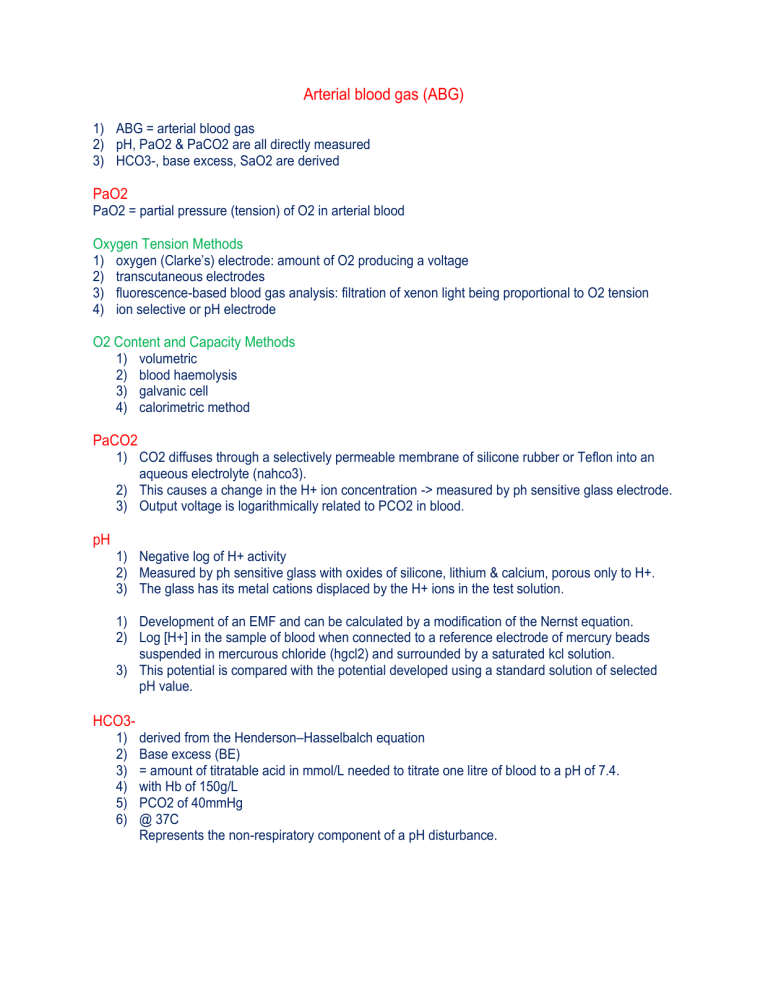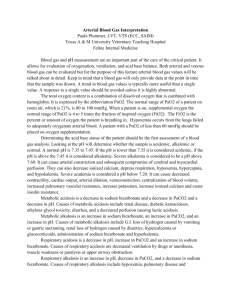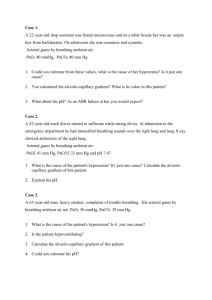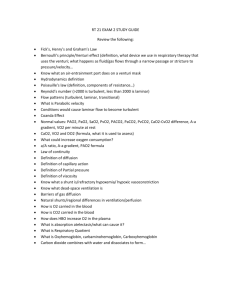
Arterial blood gas (ABG) 1) ABG = arterial blood gas 2) pH, PaO2 & PaCO2 are all directly measured 3) HCO3-, base excess, SaO2 are derived PaO2 PaO2 = partial pressure (tension) of O2 in arterial blood Oxygen Tension Methods 1) oxygen (Clarke’s) electrode: amount of O2 producing a voltage 2) transcutaneous electrodes 3) fluorescence-based blood gas analysis: filtration of xenon light being proportional to O2 tension 4) ion selective or pH electrode O2 Content and Capacity Methods 1) volumetric 2) blood haemolysis 3) galvanic cell 4) calorimetric method PaCO2 1) CO2 diffuses through a selectively permeable membrane of silicone rubber or Teflon into an aqueous electrolyte (nahco3). 2) This causes a change in the H+ ion concentration -> measured by ph sensitive glass electrode. 3) Output voltage is logarithmically related to PCO2 in blood. pH 1) Negative log of H+ activity 2) Measured by ph sensitive glass with oxides of silicone, lithium & calcium, porous only to H+. 3) The glass has its metal cations displaced by the H+ ions in the test solution. 1) Development of an EMF and can be calculated by a modification of the Nernst equation. 2) Log [H+] in the sample of blood when connected to a reference electrode of mercury beads suspended in mercurous chloride (hgcl2) and surrounded by a saturated kcl solution. 3) This potential is compared with the potential developed using a standard solution of selected pH value. HCO31) 2) 3) 4) 5) 6) derived from the Henderson–Hasselbalch equation Base excess (BE) = amount of titratable acid in mmol/L needed to titrate one litre of blood to a pH of 7.4. with Hb of 150g/L PCO2 of 40mmHg @ 37C Represents the non-respiratory component of a pH disturbance. Standard Base Excess (SBE) same as above but corrected for haemoglobin as Hb is a buffer of acid (more accurately reflects the BE in the ECF) SaO2 1) Ratio of oxyhb to total Hb 2) Normal 95 to 98% Co-oximetry 1) A laboratory test involving a blood sample heated to 37 C and subjected to light of various length and assesses absorption spectra. 2) Does not require pulsatile flow 3) Measures methb, cohb and other forms of Hb 4) Uses many other wavelengths 5) Measures either venous, arterial or capillary oxygenation Errors Pre-analytical 1) 2) 3) 4) Bubbles Contamination of line with flush solution Extreme leukocytosis -> pseudohypoxaemia (from excessive in vitro o2 consumption) Ice storage in polypropylene syringes (rather than glass) -> artefactual paco2 elevation Analytical 1) Inter-analyser variability 2) Inadequate heparinization 3) Non-linearity of clark electrode when pao2 > 150mmhg 4) Lack of appropriate electrolyte temperature 5) Interference of no and halothane 6) Poor quality control 7) Abg tensions fluctuate constantly even in stable patients




